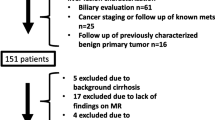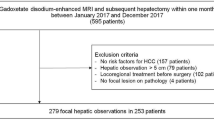Abstract
Purpose
To explore the value of DWI morphological characteristics and ADC value in differentiating malignant and benign lesions of the liver at 3.0 T.
Materials and methods
In this study, 310 patients with the same number of liver lesions confirmed by histopathology with high signal on DWI were collected. For each lesion, two radiologists independently measured the ADC values and evaluated the DWI morphological characteristics. The differences of the quantitative and qualitative MRI features determined by the readers were assessed. The ADC values of the malignant and benign liver lesions were compared. Besides, Chi-square tests were used to compare the proportion of differences in the DWI morphological characteristics between malignant and benign liver lesions. ROC curve was used to evaluate the diagnostic efficacy of ADC value and DWI morphological features.
Results
No significant differences were observed in the quantitative and qualitative MRI features determined by the readers. The ADC values for malignant liver lesions were lower than those for benign lesions (statistically significant, P < 0.05). There was significant difference in the proportion of DWI morphological features between benign and malignant liver lesions. The proportion of morphological characteristics of ring and nodular high signal intensity was higher in malignant liver lesions. In benign lesions, the proportion of flaky and homogeneous high signal morphological features was higher. The AUC of DWI morphological features + ADC value was significantly higher than those of ADC value or DWI morphological features (P = 0.0277, P < 0.0001).
Conclusions
The combined application of DWI morphological features and ADC value is the most valuable in differentiating malignant and benign liver lesions.



Similar content being viewed by others
References
Gersten O, Wilmoth JR. The cancer transition in Japan since 1951. Demogr Res. 2002;7(5):271–306. https://doi.org/10.4054/DemRes.2002.7.5.
Bray F, Ferlay J, Soerjomataram I, et al. Global Cancer Statistics 2018: GLOBOCAN estimates of incidence and mortality worldwide for 36 cancers in 185 countries. CA Cancer J Clin. 2018;68(6):394–424. https://doi.org/10.3322/caac.21492.
Wei C, Tan J, Xu L, et al. Differential diagnosis between hepatic metastases and benign focal lesions using DWI with parallel acquisition technique: a meta-analysis. Tumour Biol. 2015;36(2):983–90. https://doi.org/10.1007/s13277-014-2663-9.
Mannelli L, Bhargava P, Osman SF, et al. Diffusion-weighted imaging of the liver: a comprehensive review. Curr Prob Diagn Radiol. 2013;42(3):77–83. https://doi.org/10.1067/j.cpradiol.2012.07.001.
Guiu B, Cercueil JP. Liver diffusion-weighted MR imaging: the tower of Babel? Eur Radiol. 2011;21(3):463–7. https://doi.org/10.1007/s00330-010-2017-y.
Ginat DT, Mangla R, Yeaney G, et al. Diffusion-weighted imaging for differentiating benign from malignant skull lesions and correlation with cell density. AJR Am J Roentgenol. 2012;198(6):W597–601. https://doi.org/10.2214/AJR.11.7424.
Kim S, Jain M, Harris AB, et al. T1 hyperintense renal lesions: characterization with diffusion-weighted MR imaging versus contrast-enhanced MR imaging. Radiology. 2009;251(3):796–807. https://doi.org/10.1148/radiol.2513080724.
Sandrasegaran K, Sundaram CP, Ramaswamy R, et al. Usefulness of diffusion-weighted imaging in the evaluation of renal masses. AJR Am J Roentqenol. 2010;194(2):438–45. https://doi.org/10.2214/AJR.09.3024.
Wang H, Cheng L, Zhang X, et al. Renal cell carcinoma: diffusion-weighted MR imaging for subtype differentiation at 3.0 T. Radiology. 2010;257(1):135–43. https://doi.org/10.1148/radiol.10092396.
Onur MR, Cicekci M, Kayali A, et al. The role of ADC measurement in differential diagnosis of focal hepatic lesions. Eur J Radiol. 2012;81(3):e171-176. https://doi.org/10.1016/j.ejrad.2011.01.116.
Holzapfel K, Bruegel M, Eiber M, et al. Characterization of small (≤ 10 mm) focal liver lesions: value of respiratory-triggered echo-planar diffusion-weighted MR imaging. Eur J Radiol. 2010;76(1):89–95. https://doi.org/10.1016/j.ejrad.2009.05.014.
Kaya B, Koc Z. Diffusion-weighted MRI and optimal b-value for characterization of liver lesions. Acta Radiol. 2014;55(5):532–42. https://doi.org/10.1177/0284185113502017.
Park HJ, Kim SH, Jang KM, et al. Differentiating hepatic abscess from malignant mimickers: value of diffusion-weighted imaging with an emphasis on the periphery of the lesion. J Magn Reson Imaging. 2013;38(6):1333–41. https://doi.org/10.1002/jmri.24112.
Karan B, Erbay G, Koc Z, et al. Utility of diffusion-weighted MRI to detect changes in liver diffusion in benign and malignant distal bile duct obstruction: the influence of choice of b-values. Can Assoc Radiol J. 2016;67(4):395–401. https://doi.org/10.1016/j.carj.2016.03.006.
Taouli B, Vilgrain V, Dumont E, et al. Evaluation of liver diffusion isotropy and characterization of focal hepatic lesions with two single-shot echo-planar MR imaging sequences: prospective study in 66 patients. Radiology. 2003;226(1):71–8. https://doi.org/10.1148/radiol.2261011904.
Lee NK, Kim S, Kim DU, et al. Diffusion-weighted magnetic resonance imaging for non-neoplastic conditions in the hepatobiliary and pancreatic regions: pearls and potential pitfalls in imaging interpretation. Abdom Imaging. 2015;40(3):643–62. https://doi.org/10.1007/s00261-014-0235-5.
Kudo M, Matsui O, Izumi N, et al. JSH consensus-based clinical practice guidelines for the management of hepatocellular carcinoma: 2014 update by the liver Cancer Study Group of Japan. Liver Cancer. 2014;3(3–4):458–68. https://doi.org/10.1159/000343875.
European Association for the Study of the Liver, European Organisation for Research and Treatment of Cancer. EASL-EORTC clinical practice guidelines: management of hepatocellular carcinoma. J Hepatol. 2012;56(4):908–43. https://doi.org/10.1016/j.jhep.2011.12.001.
Hardie AD, Naik M, Hecht EM, et al. Diagnosis of liver metastases: value of diffusion-weighted MRI compared with gadolinium-enhanced MRI. Eur Radiol. 2010;20(6):1431–41. https://doi.org/10.1007/s00330-009-1695-9.
Taouli B, Koh DM. Diffusion-weighted MR imaging of the liver. Radiology. 2010;254(1):47–66. https://doi.org/10.1148/radiol.09090021.
Galea N, Cantisani V, Taouli B. Liver lesion detection and characterization: role of diffusion-weighted imaging. J Magn Reson Imaging. 2013;37(6):1260–76. https://doi.org/10.1002/jmri.23947.
Koh DM, Collins DJ. Diffusion-weighted MRI in the body: applications and challenges in oncology. AJR Am J Roentgenol. 2007;188(6):1622–35. https://doi.org/10.2214/AJR.06.1403.
Saito K, Tajima Y, Harada TL. Diffusion-weighted imaging of the liver: current applications. World J Radiol. 2016;8(11):857–67. https://doi.org/10.4329/wjr.v8.i11.857.
Sasaki M, Yamada K, Watanabe Y, et al. Variability in absolute apparent diffusion coefficient values across different platforms may be substantial: a multivendor, multi-institutional comparison study. Radiology. 2008;249(2):624–30. https://doi.org/10.1148/radiol.2492071681.
Parsai A, Zerizer I, Roche O, et al. Assessment of diffusion-weighted imaging for characterizing focal liver lesions. Clin Imaging. 2015;39(2):278–84. https://doi.org/10.1016/j.clinimag.2014.09.016.
Thoeny HC, De Keyzer F. Extracranial applications of diffusion-weighted magnetic resonance imaging. Eur Radiol. 2007;17(6):1385–93. https://doi.org/10.1007/s00330-006-0547-0.
Li X, Zhang K, Shi Y, et al. Correlations between the minimum and mean apparent diffusion coefficient values of hepatocellular carcinoma and tumor grade. J Magn Reson Imaging. 2016;44(6):1442–7. https://doi.org/10.1002/jmri.25323.
Le Moigne F, Boussel L, Haquin A, et al. Grading of small hepatocellular carcinomas (≤2 cm): correlation between histology, T2 and diffusion-weighted imaging. Br J Radiol. 2014;87(141):20130763. https://doi.org/10.1259/bjr.20130763.
Funding
This study was supported by National Natural Science Foundation of China (No. 81771785). The funders had no role in research design, data collection and analysis, decision to publish or preparation of the manuscript.
Author information
Authors and Affiliations
Corresponding author
Ethics declarations
Conflict of interest
The authors declare that they have no conflict of interest.
Ethical approval
All procedures performed in studies involving human participants were in accordance with the ethical standards of the institutional and/or national research committee and with the 1964 Helsinki declaration and its later amendments or comparable ethical standards.
Additional information
Publisher's Note
Springer Nature remains neutral with regard to jurisdictional claims in published maps and institutional affiliations.
Rights and permissions
About this article
Cite this article
Zhang, H., Sheng, F., Pan, J. et al. High signal liver focal lesions on DWI: the differential diagnostic value of morphological characteristics and ADC value. Chin J Acad Radiol 4, 48–55 (2021). https://doi.org/10.1007/s42058-021-00052-8
Received:
Revised:
Accepted:
Published:
Issue Date:
DOI: https://doi.org/10.1007/s42058-021-00052-8




